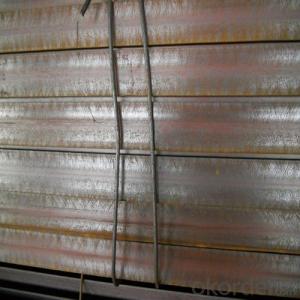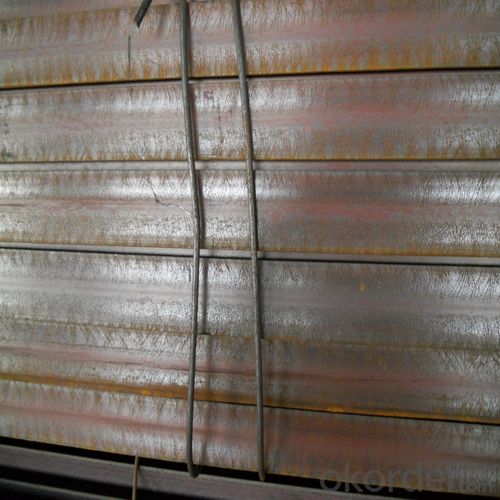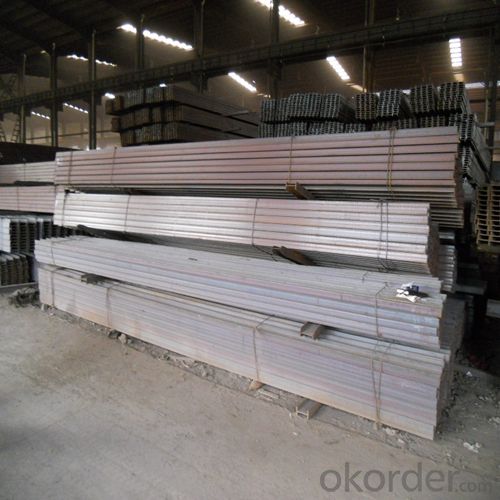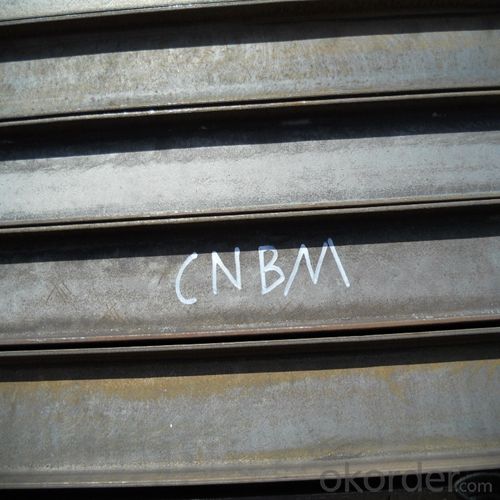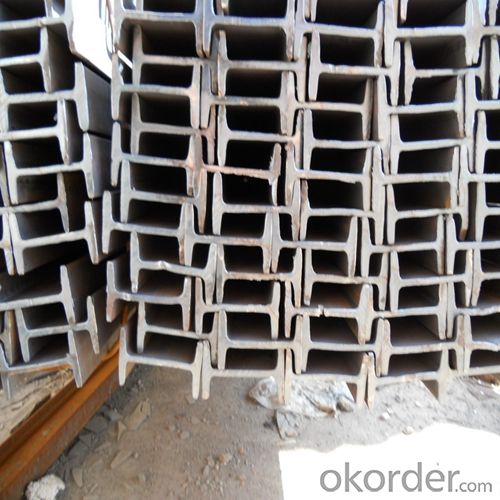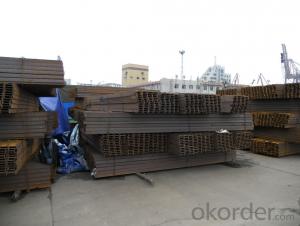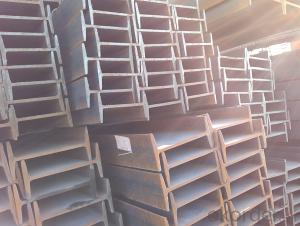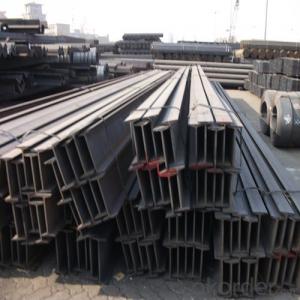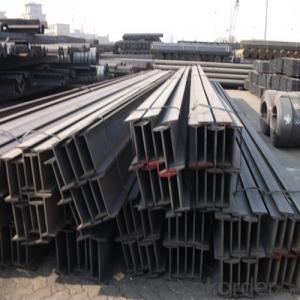Hot Rolled Structure Steel I-Beam Q235 High Quality
- Loading Port:
- Tianjin
- Payment Terms:
- TT OR LC
- Min Order Qty:
- 100 m.t.
- Supply Capability:
- 10000 m.t./month
OKorder Service Pledge
OKorder Financial Service
You Might Also Like
Product Description:
OKorder is offering Hot Rolled Structure Steel I-Beam Q235 High Quality Good Price at great prices with worldwide shipping. Our supplier is a world-class manufacturer of steel, with our products utilized the world over. OKorder annually supplies products to European, North American and Asian markets. We provide quotations within 24 hours of receiving an inquiry and guarantee competitive prices.
Product Applications:
Hot Rolled Hot Rolled Structure Steel I-Beam Q235 High Quality are ideal for structural applications and are widely used in the construction of buildings and bridges, and the manufacturing, petrochemical, and transportation industries.
Product Advantages:
OKorder's Hot Rolled Structure Steel I-Beam Q235 High Quality are durable, strong, and resist corrosion.
Main Product Features:
· Premium quality
· Prompt delivery & seaworthy packing (30 days after receiving deposit)
· Corrosion resistance
· Can be recycled and reused
· Mill test certification
· Professional Service
· Competitive pricing
Product Specifications:
Manufacture: Hot rolled
Grade: Q235, Q345, SS400, S235JR, S275JR, S355JR
Standard: GB, JIS, ASTM ST
Certificates: ISO, SGS, BV, CIQ
Length: 5.8m – 12m, as per customer request
Surface: Painted, galvanized, punched
Packaging: Export packing, nude packing, bundled
Place of Origin: Hebei, China
No. | Depth*Flange Width (mm) | Web Thickness (mm) | Weight (Kg/m) |
10 | 100X68 | 4.5 | 11.261 |
12* | 120X74 | 5.0 | 13.987 |
14 | 140X80 | 5.5 | 16.890 |
16 | 160X88 | 6.0 | 20.513 |
18 | 180X94 | 6.5 | 24.143 |
20a | 200X100 | 7.0 | 27.929 |
20b | 200X102 | 9.0 | 31.069 |
22a | 220X110 | 7.5 | 33.070 |
22b | 220X112 | 9.5 | 36.524 |
25a | 250X116 | 8.0 | 38.105 |
25b | 250X118 | 10.0 | 42.030 |
28a | 280X122 | 8.5 | 43.492 |
28b | 280X124 | 10.5 | 47.888 |
30a* | 300X126 | 9.0 | 48.084 |
30b* | 300X128 | 11.0 | 52.794 |
32a | 320X130 | 9.5 | 52.717 |
32b | 320X132 | 11.5 | 57.741 |
36a | 360X136 | 10.0 | 60.037 |
36b | 360X138 | 12.0 | 65.689 |
40a | 400X142 | 10.5 | 67.598 |
40b | 400X144 | 12.5 | 73.878 |
IPEAA 80 | 78*46 | 3.2 | 4.95 |
IPE180 | 180*91 | 5.3 | 18.8 |
FAQ:
Q1: Why buy Materials & Equipment from OKorder.com?
A1: All products offered byOKorder.com are carefully selected from China's most reliable manufacturing enterprises. Through its ISO certifications, OKorder.com adheres to the highest standards and a commitment to supply chain safety and customer satisfaction.
Q2: How do we guarantee the quality of our products?
A2: We have established an advanced quality management system which conducts strict quality tests at every step, from raw materials to the final product. At the same time, we provide extensive follow-up service assurances as required.
Q3: How soon can we receive the product after purchase?
A3: Within three days of placing an order, we will begin production. The specific shipping date is dependent upon international and government factors, but is typically 7 to 10 workdays.
Images:
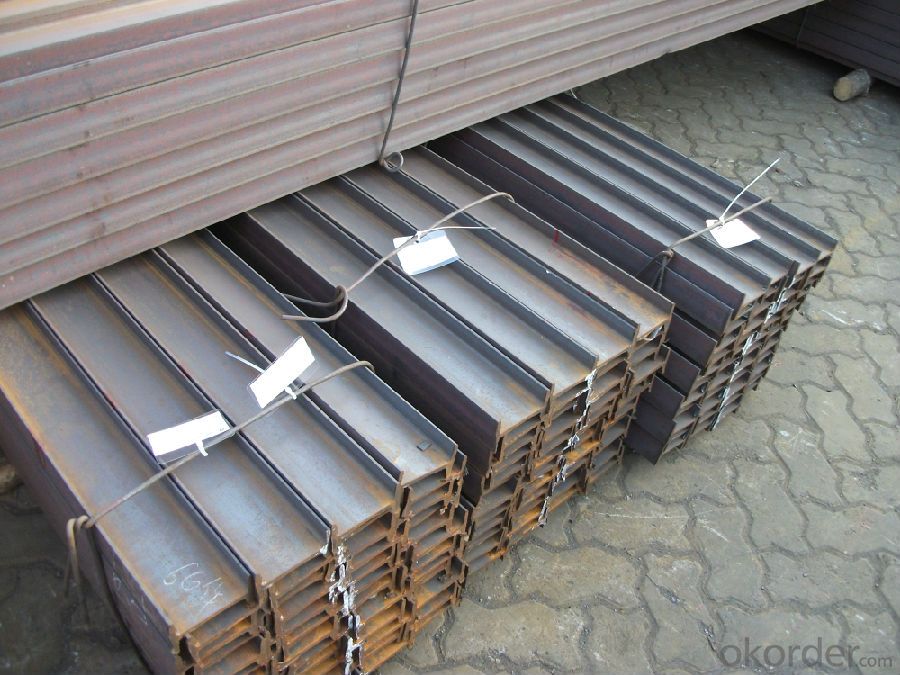
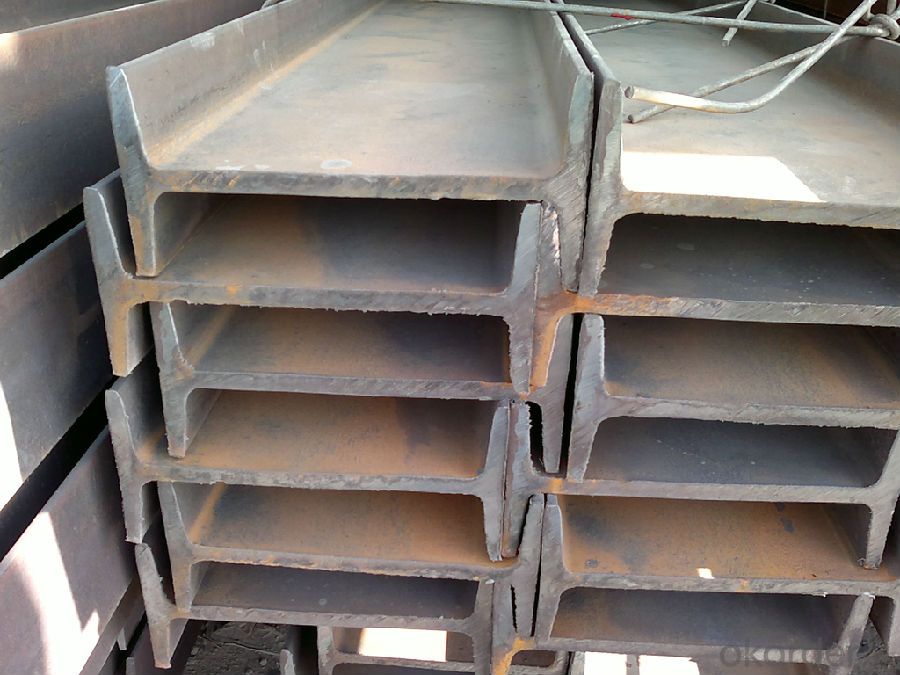
- Q: What are the different types of connections used for Steel I-Beams in bridge construction?
- Bridge construction commonly employs various types of connections for Steel I-Beams. Some commonly used types include: 1. Welded connections: The most frequently used connection in bridge construction involves welding the I-Beams at the joints to create a strong and rigid connection. Welded connections are favored due to their ability to transfer loads effectively and withstand high forces. 2. Bolted connections: This connection entails bolting the I-Beams together using high-strength bolts. Bolted connections allow for easy assembly and disassembly, making them ideal for situations requiring future modifications or relocations. However, they may not offer the same level of rigidity as welded connections. 3. Riveted connections: While riveted connections were once prevalent in bridge construction, they have become less common in modern times. This method involves using metal rivets to join the I-Beams. Although riveted connections can transfer loads effectively, their installation requires skilled labor and specialized equipment. 4. Friction connections: Friction connections employ high-strength bolts and specialized washers to create a connection reliant on surface friction for load transfer. This type of connection allows for some movement due to thermal expansion and contraction, making it suitable for long-span bridges where thermal effects are significant. Each connection type possesses its own advantages and disadvantages. The choice of connection depends on factors like design requirements, bridge location, anticipated loads, and construction methods. Selecting the appropriate connection type is crucial to ensure the bridge's structural integrity and longevity.
- Q: How do steel I-beams perform in terms of thermal insulation?
- Steel I-beams do not perform well in terms of thermal insulation. Steel is a highly conductive material, meaning it can easily transfer heat from one side to the other. This makes steel I-beams poor insulators of heat, and they are not effective in preventing the transfer of thermal energy between different areas of a structure. Therefore, if thermal insulation is a concern, additional insulation materials such as foam or fiberglass would need to be used alongside steel I-beams to achieve proper insulation.
- Q: Can steel I-beams be used for industrial warehouses?
- Yes, steel I-beams are commonly used for industrial warehouses due to their high strength and load-bearing capacity. They provide structural support and can withstand heavy loads, making them ideal for large-scale industrial buildings.
- Q: Can steel I-beams be used for temporary structures?
- Yes, steel I-beams can be used for temporary structures. They are commonly used in construction for temporary supports, such as scaffolding and shoring, due to their strength and durability.
- Q: What are the different methods of reinforcing steel I-beams against seismic forces?
- There are several methods to reinforce steel I-beams against seismic forces. One common method is using cross braces, which are diagonal steel members that connect the flanges of the I-beam, providing additional stiffness and resisting lateral forces. Another method is adding steel plates to the flanges and web of the I-beam, known as flange and web stiffeners, which increase the beam's resistance to bending and shearing. Additionally, steel channels or angles can be welded to the sides of the I-beam to enhance its strength and rigidity. These methods help to improve the overall performance and stability of steel I-beams during seismic events.
- Q: What are the design considerations for steel I-beams in high-wind areas?
- Steel I-beams in high-wind areas require careful design considerations to ensure the building's structural integrity and safety. Here are some key factors to consider: 1. Wind loads: In high-wind areas, strong wind forces exert significant pressure on the building. Engineers must calculate the expected wind loads on the I-beams using wind speed data and regional wind codes. This information helps determine the necessary strength and size of the beams. 2. Material choice: While steel is commonly used due to its high strength-to-weight ratio and durability, high-quality steel with excellent resistance to corrosion and fatigue is crucial in high-wind areas. Galvanized or stainless steel, known for enhanced corrosion resistance, is often preferred. 3. Beam dimensions and shape: The dimensions of the I-beam, including height, flange width, and thickness, are determined based on calculated loads. In high-wind areas, larger and deeper beams are often used to accommodate increased wind forces. The specific shape of the beam is crucial as it affects its resistance to bending and torsion. 4. Connection design: Connections between steel I-beams and other structural elements, such as columns and foundations, play a critical role in withstanding high-wind loads. Attention must be given to connection details to ensure effective transfer of wind-induced forces. Sufficient strength and rigidity are achieved through adequate bolting, welding, or other connection methods. 5. Bracing and stability: Additional bracing is necessary in high-wind areas to prevent lateral deflection and maintain stability. Diagonal bracing or moment frames can be incorporated into the design to resist wind-induced forces. These bracing systems distribute wind loads throughout the structure, minimizing the risk of structural failure. 6. Building codes and regulations: Compliance with local building codes and regulations is essential for designing steel I-beams in high-wind areas. These codes provide guidelines on wind loads, material specifications, connection design, and other safety considerations. Engineers must ensure their designs meet or exceed the minimum requirements specified by relevant codes. 7. Testing and analysis: Prior to construction, engineers may perform structural analysis through computer simulations or physical testing to validate the design's effectiveness. These tests evaluate the performance of I-beams under different wind conditions, refining the design and ensuring reliability. By considering these factors and implementing appropriate design measures, engineers can improve the performance and safety of steel I-beams in high-wind areas, creating a robust and durable structural solution.
- Q: How do steel I-beams contribute to sustainable building practices?
- Steel I-beams contribute to sustainable building practices in several ways. Firstly, steel is one of the most sustainable building materials available. It is 100% recyclable, which means that any steel used in construction can be easily and efficiently repurposed at the end of a building's life cycle. This reduces the need for new raw materials and minimizes waste. Secondly, steel I-beams are incredibly durable and long-lasting. They have a high strength-to-weight ratio, which means that they can support heavy loads without adding excessive weight to the structure. This durability reduces the need for frequent repairs or replacements, resulting in lower maintenance costs and less waste over time. Moreover, steel I-beams can be prefabricated off-site and then transported to the construction site. This process requires less energy and resources compared to on-site fabrication, reducing the carbon footprint of the building project. Additionally, the use of prefabricated steel components can significantly decrease construction time, leading to less disruption to the surrounding environment and a more efficient use of resources. Furthermore, steel I-beams can be designed to maximize energy efficiency in buildings. They can support the integration of insulation materials, allowing for better thermal performance and reducing the need for excessive heating or cooling. Additionally, steel can be used in combination with other sustainable building systems, such as renewable energy technologies or green roofs, to further enhance the overall sustainability of the building. Lastly, steel I-beams are resistant to fire, pests, and extreme weather conditions, making them a reliable choice for sustainable construction. The longevity of steel structures reduces the need for frequent rebuilding, saving resources and minimizing the environmental impact of the construction industry. In conclusion, steel I-beams contribute to sustainable building practices by being recyclable, durable, energy-efficient, and resistant to various hazards. Their use in construction promotes resource conservation, reduces waste, and helps create environmentally friendly buildings that can endure for generations.
- Q: What are the different types of steel I-beam connections for beam-to-beam joints?
- There exist various options for connecting steel I-beams at beam-to-beam joints. Some of the most frequently used types comprise: 1. Employing welded connections: This approach involves fusing the two beams together at the joint. It yields a sturdy and inflexible connection, yet demands skilled labor and can be time-consuming. 2. Utilizing bolted connections: This method necessitates the use of bolts and nuts to secure the beams at the joint. It is simpler to assemble and disassemble in comparison to welded connections, though it may not offer as much rigidity. 3. Employing riveted connections: This traditional technique entails using rivets to connect the beams. While it is less commonly employed nowadays, it furnishes a robust and long-lasting connection. 4. Implementing moment connections: These connections are specifically designed to transfer bending moments between the beams. They are typically employed in situations where the beams encounter heavy loads and require additional support. 5. Utilizing shear connections: These connections are intended to transfer shear forces between the beams. They are commonly employed in situations where the beams are exposed to lateral loads or wind forces. 6. Opting for slotted connections: This type of connection involves incorporating slots in the beams to allow for adjustability and flexibility. It is often employed when precise alignment or adjustment is required. Considering the specific project requirements and consulting with a structural engineer is crucial in order to determine the most suitable type of steel I-beam connection for beam-to-beam joints. Factors such as load capacity, structural design, and ease of installation should be taken into account when selecting the appropriate connection method.
- Q: Are there any limitations to the use of steel I-beams in construction?
- Yes, there are some limitations to the use of steel I-beams in construction. One limitation is their weight. Steel I-beams are typically heavy, which makes them more challenging to transport and install. This can increase the cost and complexity of construction projects, especially in areas with difficult access or limited resources for heavy lifting equipment. Another limitation is the potential for corrosion. If steel I-beams are not properly protected, they can rust and weaken over time. This is particularly an issue in environments with high humidity, saltwater exposure, or chemical pollutants. Regular maintenance and protective coatings are necessary to prevent corrosion and ensure the longevity of the I-beams. Additionally, steel I-beams have limitations in terms of their span length. The longer the span, the more the beams tend to deflect under load, which can compromise the structural integrity and stability of the building. In such cases, additional supports or alternative structural solutions may be required to overcome this limitation. Moreover, steel I-beams have limited fire resistance. When exposed to high temperatures, steel can lose its strength and structural integrity. Fire protection measures, such as fire-resistant coatings or the addition of fireproofing materials, are necessary to mitigate this limitation and ensure the safety of the building occupants. Lastly, steel I-beams are susceptible to thermal expansion and contraction. When exposed to extreme temperature variations, such as in regions with hot summers and cold winters, the steel can expand and contract, potentially causing structural issues. Proper expansion joints and design considerations must be implemented to accommodate these thermal movements. Despite these limitations, steel I-beams remain widely used in construction due to their strength, durability, and cost-effectiveness. However, it is essential to consider these limitations and address them appropriately in the design and construction process to ensure the safety and longevity of the structure.
- Q: What are the factors to consider when selecting steel I-beams for a project?
- When selecting steel I-beams for a project, there are several factors to consider. Firstly, the load capacity required for the project should be evaluated, as this will determine the size and strength of the I-beam needed. The span or length of the beam is also crucial, as longer spans may require larger and heavier beams. Additionally, the type of construction and intended use of the I-beam should be taken into account, as different applications may require specific types of beams, such as wide-flange or standard I-beams. Finally, considering factors like cost, availability, and the overall design requirements of the project can help ensure the selection of the most suitable steel I-beam.
Send your message to us
Hot Rolled Structure Steel I-Beam Q235 High Quality
- Loading Port:
- Tianjin
- Payment Terms:
- TT OR LC
- Min Order Qty:
- 100 m.t.
- Supply Capability:
- 10000 m.t./month
OKorder Service Pledge
OKorder Financial Service
Similar products
Hot products
Hot Searches
Related keywords
